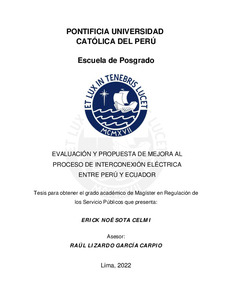| dc.contributor.advisor | Garcia Carpio, Raul Lizardo | |
| dc.contributor.author | Sota Celmi, Erick Noe | |
| dc.date.accessioned | 2023-01-18T18:52:28Z | |
| dc.date.available | 2023-01-18T18:52:28Z | |
| dc.date.created | 2022 | |
| dc.date.issued | 2023-01-18 | |
| dc.identifier.uri | http://hdl.handle.net/20.500.12404/24043 | |
| dc.description.abstract | En la actualidad existe solo una línea de interconexión en el nivel de 220 kV con el vecino país
de Ecuador, por donde se han efectuado intercambios de electricidad con Perú en situaciones
especiales. Tanto Perú como Ecuador, al formar parte de la Comunidad Andina de Naciones,
han logrado afianzar la interconexión eléctrica en base a los Acuerdos Bilaterales, por ello la
investigación procura diagnosticar el grado de integración entre estos países y poder comprender
hacia donde deberíamos apuntar de manera individual o conjunta, para lograr una integración
regional y así volver más eficiente la producción energética que en años anteriores se ha visto
afectada por la falta de inversión en sus mercados.
En las reuniones ministeriales que se llevan a cabo a partir del Acuerdo de Cartagena, los países
miembros han propuesto incluir en la planificación de cada sistema los proyectos que propicie
la integración eléctrica, con la finalidad de asegurar en calidad y confiabilidad el suministro
eléctrico. En ese sentido, Proinversión en el corto plazo licitará el proyecto de interconexión con
Ecuador en el nivel de 500 kV, el cual incrementaría los intercambios internacionales de
electricidad.
En esta investigación se realizan simulaciones de un sistema eléctrico binodal utilizando el
modelado algebraico del software General Algebraic Modeling System (GAMS por sus siglas en
inglés) para poder determinar el nivel óptimo de transmisión el cual, al considerar los costos
asociados a la transmisión en la función objetivo, interioriza y compara dichos costos con los
ahorros que se obtendrían por importar/exportar energía desde otro sistema. Estas simulaciones
se basan en las máximas demandas y en la función de costos marginales de cada sistema, así
como en una explicación sobre el nivel de integración en la cual se encuentra Perú y Ecuador.
En base a ello se evalúan los proyectos actuales y su regulación y se realizan algunas propuestas
de mejora para que sean analizadas por el Estado. | es_ES |
| dc.description.abstract | Currently there is only one interconnection line at the 220 kV level with the neighbouring
country of Ecuador, through which electricity exchanges with Peru have been due in special
situations. Both Peru and Ecuador, being part of the Andean Community of Nations, have
managed to strengthen the electrical interconnection based on Bilateral Agreements, for this
reason the investigation will seek to detect the degree of integration between these countries and
be able to understand where we should aim individually or jointly, to achieve regional integration
and thus make energy production more efficient, which in previous years has been affected by
the lack of investment in its markets.
In the ministerial meetings that are held from the Cartagena Agreement, the member countries
have proposed to include in the planning of each system the projects that promote electrical
integration, to ensure the quality and reliability of the electrical supply. In this sense, in the short
term, Proinversión will put out to tender the interconnection project with Ecuador at the 500
kV level, which would increase international electricity exchanges.
In this research, simulations of a binodal electrical system are carried out using the algebraic
modelling of the General Algebraic Modelling System (GAMS) software to determine the
optimal level of transmission which, when considering the costs associated with transmission in
the objective function, internalizes and compares these costs with the savings that would be
obtained by importing/exporting energy from another system. These simulations are based on
the maximum demands and the marginal cost function of each system, as well as an explanation
of the level of integration in which Peru and Ecuador find themselves. | es_ES |
| dc.language.iso | spa | es_ES |
| dc.publisher | Pontificia Universidad Católica del Perú | es_ES |
| dc.rights | info:eu-repo/semantics/openAccess | es_ES |
| dc.rights.uri | http://creativecommons.org/licenses/by-nc/2.5/pe/ | * |
| dc.subject | Perú--Relaciones exteriores--Ecuador | es_ES |
| dc.subject | Energía eléctrica | es_ES |
| dc.title | Evaluación y propuesta de mejora al proceso de interconexión eléctrica entre Perú y Ecuador | es_ES |
| dc.type | info:eu-repo/semantics/masterThesis | es_ES |
| thesis.degree.name | Magíster en Regulación de los Servicios Públicos | es_ES |
| thesis.degree.level | Maestría | es_ES |
| thesis.degree.grantor | Pontificia Universidad Católica del Perú. Escuela de Posgrado | es_ES |
| thesis.degree.discipline | Regulación de los Servicios Públicos | es_ES |
| renati.advisor.dni | 09951306 | |
| renati.advisor.orcid | https://orcid.org/0000-0001-9100-8056 | es_ES |
| renati.author.dni | 43608930 | |
| renati.discipline | 417697 | es_ES |
| renati.juror | Dammert Lira, Alfredo Juan Carlos | es_ES |
| renati.juror | Garcia Carpio, Raul Lizardo | es_ES |
| renati.juror | Moscol Salinas, Alejandro Martin | es_ES |
| renati.level | https://purl.org/pe-repo/renati/level#maestro | es_ES |
| renati.type | https://purl.org/pe-repo/renati/type#tesis | es_ES |
| dc.publisher.country | PE | es_ES |
| dc.subject.ocde | https://purl.org/pe-repo/ocde/ford#5.09.00 | es_ES |







